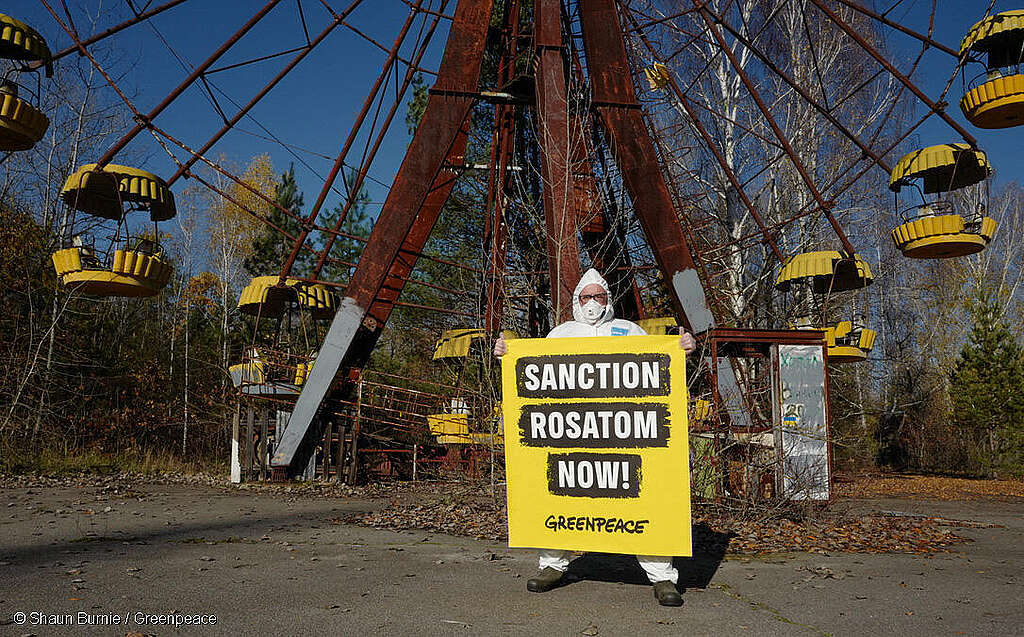
Kyiv / Brussels, 17 November 2023 – Greenpeace Germany, Greenpeace Central and Eastern Europe, and Ukrainian environmental group SaveDnipro have installed sensors to provide vital information on radiation levels in Ukraine in the event of major nuclear contamination.
Following a visit to Chornobyl, Zaporizhzhia and other frontline regions in southern Ukraine, Greenpeace and SaveDnipro installed sensors on schools, hospitals and nuclear sites which aim to provide early warning of increasing gamma radiation in case of another nuclear disaster in Ukraine.
The real-time data on radiation levels collected by the sensors will feed into an online map called SaveEcoBot. There are sensors in Zaporizhzhia City, Yuzhnoukrainsk, Odessa, Tarutyne, Yuzhne, and Uman. They have been installed with the approval of local authorities responsible for nuclear emergency planning.
The Greenpeace and SaveDnipro radiation sensors, along with emergency radiation recommendations, support the efforts of the local authorities and emergency services, providing an additional layer of protection for the local population.
Jan van de Putte, radiation specialist with Greenpeace Belgium and Greenpeace East Asia, said: “Our radiation sensors can’t stop radiation, but they can provide vital information that can save lives in the possible event of a deliberate nuclear disaster. Having listened to the voices of local authorities and politicians across southern Ukraine, and following up on their efforts, Greenpeace is deeply committed to its work of supporting the Ukrainian population. By working hand in hand with local authorities and organisations, we are strengthening our capacity to monitor and respond to nuclear disaster risks together.”
Pavlo Tkachenko, technical director and co-founder of SaveDnipro, said: “Over the last 20 months of full-scale war, Russian forces have repeatedly attacked Ukrainian nuclear facilities and spread false information about radiation levels in Ukraine. This has sparked global concern about radiation safety in the country. To address this, there’s a need to develop independent online networks and more transparent radiation monitoring through civic projects like our SaveEcoBot. These efforts can help reassure the public about the normal radiation levels in Ukraine and, in case of potential threats, provide the government with more data for decision-making.”
Greenpeace urges immediate EU sanctions against Rosatom, the Russian state nuclear agency in charge of Russian nuclear weapons and occupied nuclear sites in Ukraine, as the risk of a nuclear disaster increases due to the Russian war against Ukraine.
Shaun Burnie, nuclear specialist with Greenpeace East Asia, said: “With the approaching winter, the risk of a nuclear disaster increases each day. It is outrageous that Rosatom is still treated by certain EU states as a respected business partner rather than a criminal nuclear blackmailer. The time has long passed when the Russian nuclear industry, Rosatom, should be punished by comprehensive sanctions. Those corporations in Europe, such as Framatome and Siemens, and governments with deep commercial ties to Rosatom, such as France and Hungary, are directly fuelling the Russian war against Ukraine and its people. Sanctions must be imposed that end nuclear trade with Russia.”
Demands for sanctions against Rosatom, supported by Ukrainian authorities and five EU governments, have so far been consistently blocked by EU governments with ties to the nuclear industry.
The compromised security of nuclear power plants in Ukraine and the potential threat of a nuclear disaster underlines the need for immediate sanctions.
The illegal occupation of the Zaporizhzhia Nuclear Power Plant since March 2022 by Rosatom and the Russian armed forces has made the power plant particularly vulnerable to severe damage. The emergency response and safety management procedures are no longer functioning, with very limited information being provided by International Atomic Energy Agency (IAEA) inspectors. The threat of further destructive actions and environmental war crimes by Russian forces, coupled with the ever-present risk of electricity supply loss, places the entire region, as well as Ukraine and potentially neighbouring countries, at risk.
Russian targeting of Ukraine’s energy sector increases the risk of a nuclear disaster, not just at the Zaporizhzhia nuclear plant, but also at other operating nuclear reactors. In March 2022, Russian armed forces attempted to seize the South Ukraine Nuclear Power Plant in the Mykolaiv region. In October 2023, missile attacks close to the Khmelnitsky Nuclear Power Plant damaged the plant’s administrative buildings. The prospect of radioactive contamination also increased following the destruction of the Nova Kakhovka dam in June 2023.
Additional resources:
On 17 November, Greenpeace and SaveDnipro held a press conference about the sensors and the call for sanctions against Rosatom. A recording of the press conference is available.
Photo and video of the Greenpeace mission in southern Ukraine are available to download.
Read Greenpeace Germany and Greenpeace France’s July 2023 report, Russia’s Atomic Partners: Framatome, Siemens Energy And Rosatom
Read McKenzie Intelligence and Greenpeace Germany’s September 2023 report, A Nuclear Power Plant as Launch Pad
Contacts:
Mattea Weihe, Greenpeace Germany press officer: [email protected]
Pavlo Tkachenko, Save Dnipro technical director and founder: [email protected]
Greenpeace EU press desk: +32 (0)2 274 1911, [email protected]
For breaking news and comment on EU affairs: www.twitter.com/GreenpeaceEU
Greenpeace is an independent global campaigning network that acts to change attitudes and behaviour, to protect and conserve the environment and to promote peace. We do not accept donations from governments, the EU, businesses or political parties. Greenpeace has over three million supporters, and 26 independent national and regional organisations with offices in more than 55 countries.
EU Transparency Register: 9832909575-41
